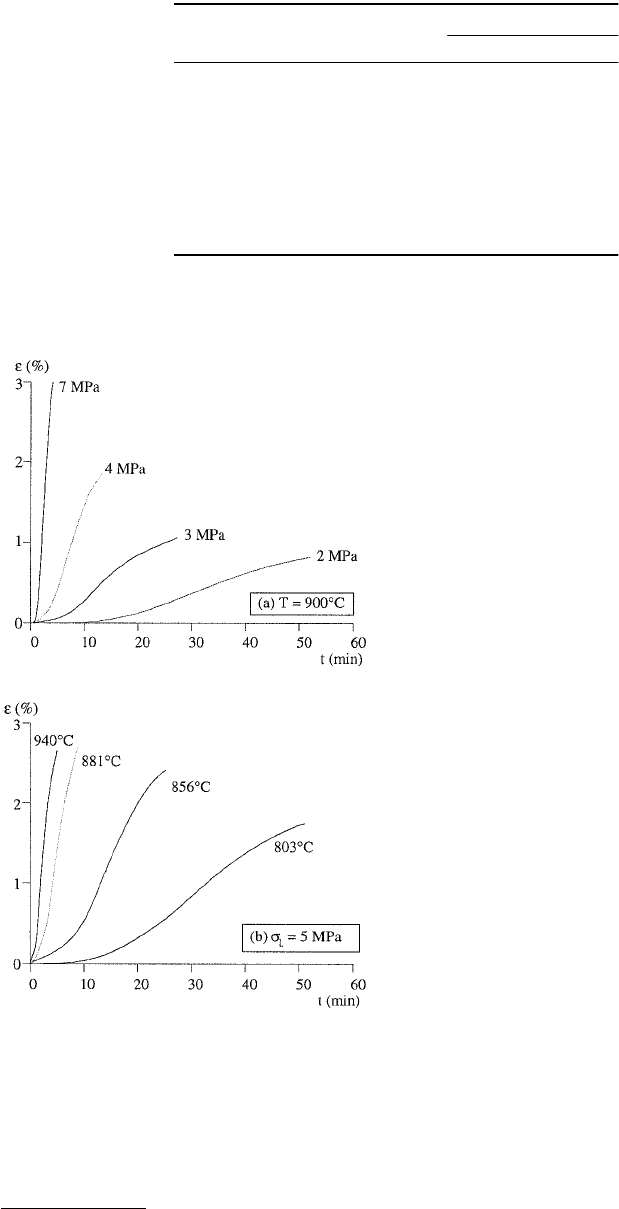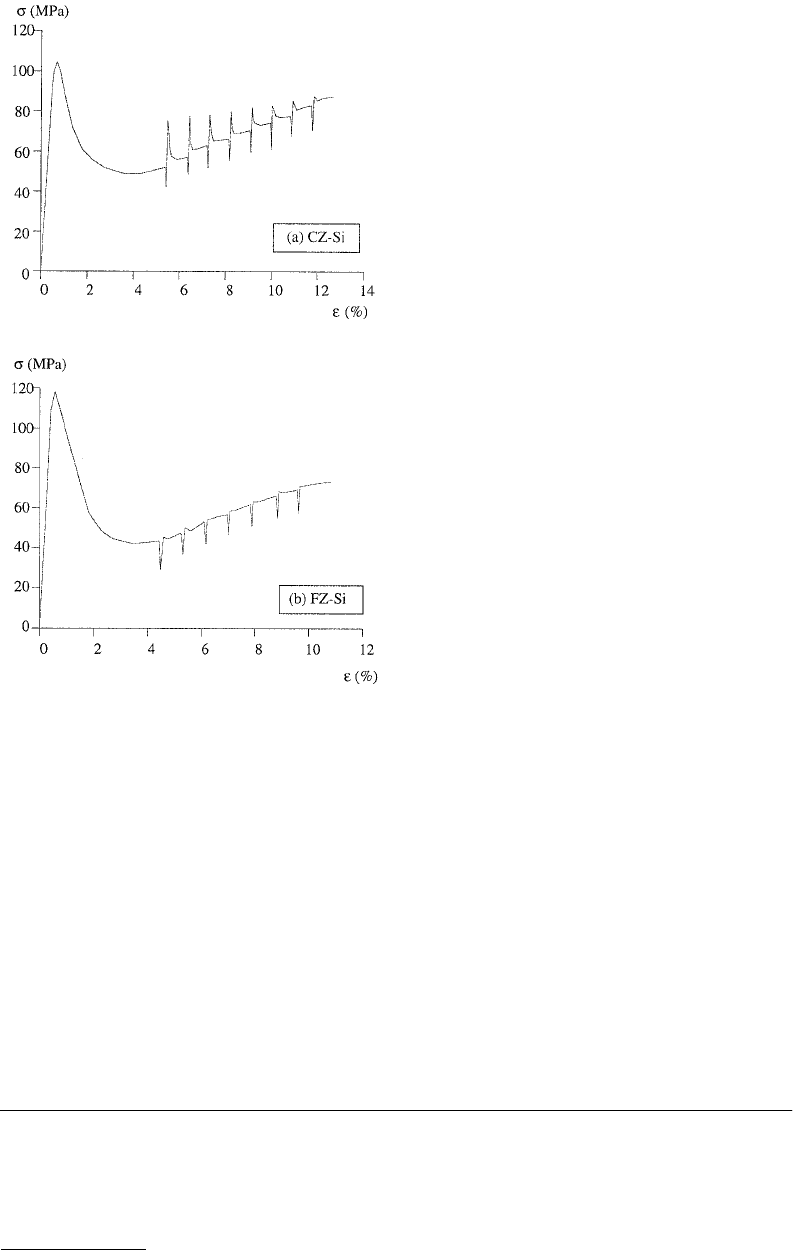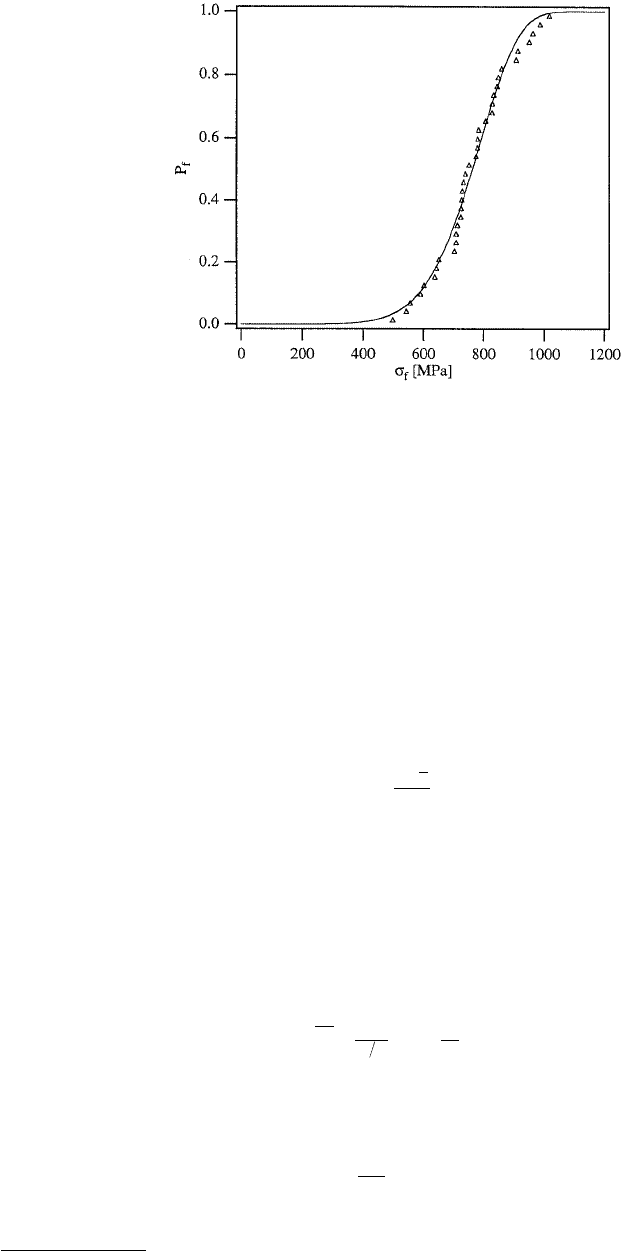Bhushan B. Handbook of Micro/Nano Tribology, Second Edition
Подождите немного. Документ загружается.


© 1999 by CRC Press LLC
a level of 2 · 10
18
cm
–3
will cause an increase of
·
ε
max
by a factor of 10, whereas doping with B to the same
level will lower the strain rate by a factor of 0.5 (Milvidskij et al., 1966).
Aging means that the mechanical properties of a material are changed by thermal, thermochemical,
or thermomechanical processes during a period of time. If a semiconductor is thermally aged at elevated
temperature in some process step, the Cottrell atmospheres around the dislocations may dissolve and
the yield limit will be correspondingly lowered. On return to lower temperature, the Cottrell atmospheres
Table 15.6 Microhardness Values Obtained by Vickers
Indentation at 50g Load (polarity effect neglected)
H
v
Indentation orientation
(GPa) 1 2
Si(111) 10.8 ± 1.3 [
–
110] [11
–
2]
Si(100) 11.2 ± 1.0 [011] [0
–
11]
Si(110) 11.3 ± 1.1 [001] [1
–
10]
Ge(111) 9.2 ± 0.5 Undefined
GaAs(100) 6.9 ± 0.3 [011] [0
–
11]
GaAs(100)(doped) 6.9 ± 0.1 Undefined
GaAs(111) 7.0 ± 0.2 [
–
110] [11
–
2]
InP(100) 4.3 ± 0.2 [011] [0
–
11]
InAs(polycrystalline) 3.5 ± 0.1 Undefined
Orientations 1 and 2 are the two diagonals of the indentation mark.
Data from Ericson, F. et al., 1988, Mater. Sci. Eng. A 105/106, 131.
With permission.
FIGURE 15.6 Creep curves for silicon (Reppich et al.,
1964). (a) Varying applied stress at 900°C, and (b) varying
temperature at 5 MPa applied stress. (Adapted from Rep-
pich, B. et al., Acta Met. 12, 1283.)

© 1999 by CRC Press LLC
will not always reestablish themselves, but the impurities instead prefer to form small, particle-like
precipitates, resulting in a maintained low yield limit, see Figure 15.5. Also, during plastic deformation
these precipitates may act as sources for generation of new dislocations, hence affecting the strain
hardening behavior of the material. For these reasons, the thermal history of a semiconductor material
is of great importance to its plasticity behavior.
Strain aging is a thermomechanical effect causing recovery of a plasticized material after unloading,
and a raised yield limit with yield drop upon reloading. Figure 15.7 shows examples of the strain aging
behavior of CZ-Si and FZ-Si at 800°C (Yasutake et al., 1982b). Other thermomechanical phenomena are
thermal chock and thermal fatigue. These effects are discussed in the Section 15.6.
As was previously mentioned, plastic deformation of a micromachined construction element usually
is detrimental to the structure, and is therefore avoided by a proper choice of materials, ample dimen-
sioning, or simply by avoiding overloads. On the other hand, micromachined structures offer one of the
few existing means of investigating the plasticity and the thermomechanical behavior of thin films (Smith
et al., 1991; Kristensen et al., 1991a,b; Ericson et al., 1991).
15.6 Fracture Properties
15.6.1 Fracture Limit and Fracture Toughness
First of all, it is important to clarify the fact that the fracture limit is not a materials property, but essentially
a design property. This implies that the “intrinsic” strength properties of a material, for instance, expressed
FIGURE 15.7 Strain aging behavior at 800°C of (a)
Czochralski-grown Si and (b) float-zone-grown Si.
(From Yasutake et al., 1982b.)

© 1999 by CRC Press LLC
in terms of the interatomic bond strength, are of less importance to the overall strength of a component
than pure design factors such as geometric shape, surface roughness, how the load is applied, etc.
Obviously, the intrinsic strength is not completely without importance, and is sometimes used to define
an upper, theoretical strength limit, the so-called theoretical fracture limit, commonly given by
(15.30)
E is the Young’s modulus, γ is the surface energy, and a
o
is the distance between atomic planes parallel
to the crack plane. In a generalized representation, the γ value in Equation 15.30 should be the fracture
surface energy, i.e., one half of a cleavage energy including the broken bond energies as well as the energy
of the dynamic elastic stress field around the propagating crack (this energy is eventually dissipated as
heat) and energy dissipated or stored by plastic deformation or other irreversible processes during
cracking. Usually σ
th
is of an order of E/10 or E/5, but the practical fracture limit often is several orders
of magnitude lower due to design factors.
Hence, the practical fracture limit, although important in design, is not a useful measure of the general
fracture strength of a material. A more useful concept is the fracture toughness ( = the critical stress
intensity factor) K
Ic
, which is considered to be a true, or nearly true, materials constant. For instance,
for a body containing a stress-concentrating sharp crack of length c perpendicular to the applied load,
K
Ic
is related to the effective fracture limit σ
c
of the body by:
(15.31)
Y is a dimensionless factor which equals 1.12 for a surface crack and 1/ for an interior crack. Both Y
and σ
c
are geometry dependent, but according to practical experience they are related in such a manner
that K
Ic
of Equation 15.31 becomes independent of crack geometry. Expressions similar to Equation 15.31
exist also for stress-concentrating geometries other than sharp cracks. The subscript “I” refers to fracture
of mode I type, i.e., tensile cracking perpendicularly to the applied load. Modes II and III are cracking
during longitudinal or transverse shearing, i.e., shearing in the crack propagation direction or transversely
to it, respectively. In brittle materials, modes II and III rarely occur.
Similarly to σ
th
of Equation 15.30, K
Ic
can be related to the surface energy and the Young’s modulus.
For plane strain, we have
(15.32)
and, for plane stress,
(15.33)
Combining Equations 15.30 and 15.33, we obtain a formal and simple relationship between the theoretical
fracture limit and the fracture toughness:
(15.34)
σγ
th
=
()
Ea
o
12
.
KYc
ccI
=πσ.
2
KE
cI
=−
()
[]
21
2
12
γν,
KE
cI
=
[]
2
12
γ .
Ka
coIth
=σ 2.

© 1999 by CRC Press LLC
15.6.2 Some Fracture Data
In single-crystalline materials fracture data are anisotropic. In Table 15.7 fracture data for differently
oriented cleavage planes in Si are listed (Johansson et al., 1989). These data are interrelated by
Equations 15.33 and 15.34. It is seen that (111) is the low-energy cleavage plane, in agreement with
common experience. In practice, cleavage is sometimes observed also in (110) planes in Si, whereas
cleavage along (100) is difficult to achieve. In GaAs the preferential cleavage planes are of (110) type
(Blakemore, 1982). Averaged (isotropic) fracture toughness data for a number of semiconductors have
been determined by indentation and solid particle erosion techniques (Ericson et al., 1988). Fracture
data from erosion experiments are listed in Table 15.8. In this case, the γ values have been calculated by
means of Equation 15.32.
Measured fracture stresses for single-crystalline Si microbeams can be very high: 6.1 GPa on the average
was found in one investigation (Ericson and Schweitz, 1990). For comparison, an extremely high-strength
steel has a fracture limit of ~1 GPa. Introduction of a thermal oxide film 0.53 µm thick (which consumed
the top 0.23 µm of the Si surface) was found to raise the fracture strength to 7.2 GPa; subsequent removal
of the oxide by HF treatment lowered the strength marginally to 6.6 GPa, i.e., still 10% higher than the
original strength. This behavior is explained by the fact that all submicron damage present in the original
silicon surface was incorporated in the oxide film. Possibly some of the damage was “healed” in the oxide
by the formation of oxygen bridges, which could explain the increased fracture limit of the oxidized
beam. But more important is that the elastic modulus of SiO
2
is much lower than for Si, and the stress
concentrations at the surface damage were correspondingly reduced. Subsequent removal of the oxide
by HF treatment also removed the original surface defects. The high fracture limit after removal indicates
that the resulting Si surface was less imperfect than the original surface. Tensile tests performed on surface
micromachined polysilicon structures show a widespread in the presented data. Greek et al. (1997)
presented measured fracture strength values of 566 and 768 MPa for two different polysilicon films, while
Tsuchiya et al. (1997) presented values in the range of 2.0 to 2.7 GPa. The large difference between the
two investigations is mainly due to differences in techniques used to etch out the test specimens. The
TABLE 15.7 Fracture Data for Different Cleavage Planes in Si (Johansson
et al.,1989)
Fracture Plane E (GPa) a
o
(Å) K
Ic
(MPa m
1/2
) σ
th
(GPa) γ (Jm
–2
)
{100} 130 1.36 0.95 58 3.52
{110} 171 1.92 0.90 46 2.38
{111} 190 3.14 0.82 33 1.80
The K
Ic
values are taken from Chen et al. (1980).
TABLE 15.8 K
Ic
Values and γ Values Deduced
from Erosion Results
Specimen E (GPa) ν K
Ic
(MPa m
1/2
) γ (Jm
–2
)
Si 163 0.22 0.94 2.58
Ge 132 0.21 0.60 1.30
GaAs 116 0.24 0.44 0.79
InP 89 0.29 0.36 0.67
InAs 76 0.28 0.32 0.62
The E and ν values are for polycrystalline specimens.
Data from Ericson, F. et al., 1988, Mater. Sci. Eng.
A105/106, 131.

© 1999 by CRC Press LLC
reactive ion-etching process in the case of Greek et al. (1997) introduced more severe surface defects on
their test specimens. Walker et al.
(1990) exposed thin polysilicon membranes to HF solutions of various
concentrations, and found opposite behavior; the fracture limits were drastically reduced. This result
might be because no surface defects were removed (since no oxidization was performed); on the contrary,
new defects might have been introduced by HF attacks on the grain boundaries.
The fracture strength of carefully bulk-micromachined GaAs has been found by Hjort et al. (1994) to
be 2.7 GPa, which is about one half of the Si value, but certainly high enough to satisfy most demands
on mechanical strength (several times higher than steel). The general notion that GaAs is extremely
fragile as compared to Si stems from the fact that wafers or components of GaAs often contain more
serious surface damage. This is a problem that is possible to overcome by a careful processing and gentle
handling of the specimens.
15.6.3 Fracture Initiation
Knowing the fracture toughness K
Ic
, and having experimentally determined the effective fracture limit
σ
c
of the body in question, Equation 15.31 opens the possibility of a postfailure evaluation of the size c
of the defect which initiated the fracture. In brittle materials like micromachined silicon, fracture is
almost always initiated at some surface defect, and sharp, vertical cracks in the surface are the most
detrimental type of defects in this respect. Although we usually do not know the exact geometry of the
initiating surface flaw, Equation 15.31 (with Y equal to 1.12) yields the c value of a defect which is
equivalent to the real defect from a fracture viewpoint, but with an assumed, known geometry.
For microbeams, bulk micromachined by conventional KOH etching in a (001) Si wafer, the initiating
defect size typically is of the order c ~ 10 nm (Johansson et al., 1988a, 1989; Ericson and Schweitz, 1990).
In beams oriented along an 〈110〉 direction, the initiating flaws have been found to be twice as large as
in beams oriented along 〈100〉 type directions. The effective fracture limit was found to be correspondingly
lower in 〈110〉 beams than in 〈100〉 beams (~4 and ~6 GPa, respectively) (Johansson et al., 1989). These
results are consistent with the observation that (110)-cleavage is energetically more favorable than (100)-
cleavage (see Table 15.7), implying that the unintentional submicron cracks which initiate fracture might
be more extended in (110) planes. In the final fracture process, on the other hand, “clean” fracture along
crystallographic planes only occurs for low-strength beams, i.e., beams containing a serious crack-
initiating defect. High-strength beams usually exhibit strongly irregular and “hackled” fracture surfaces.
This is in agreement with the theory of crack propagation, stating that low-velocity cracking (caused by
a low fracture limit) results in a smooth fracture surface — a so-called fracture mirror — whereas high-
velocity cracking results in hackled fractures. Hence, simple fractographic observations may yield some
qualitative information on the magnitude of the initiating defect.
15.6.4 Weibull Statistics
It is obvious from the discussion above that the size and shape distributions of the surface defects are of
crucial importance to the strength properties of a brittle component, and that a probabilistic approach
is called for. The most popular statistical theory of brittle fracture is due to Weibull (1939, 1951), and is
based on a weakest link argument.
The Weibull probability distribution function,
(15.35)
gives the probability of failure of a body which is exposed to a stress distribution σ
a
(x,y,z). The stressed
volume of the body is V, the stress σ
u
is a lower limit which is usually equal to zero in brittle materials,
P
xyz
dV
f
u
v
m
=− −
()
−
∫
1
0
exp
,,
,
σσ
σ
a

© 1999 by CRC Press LLC
σ
0
is a parameter related to the average fracture stress, and m is the Weibull modulus, which is a measure
of the statistical scatter displayed by the fracture events. A low m value indicates a large scatter, whereas
a high m value means low scatter. The Weibull modulus is an important measure of the engineering
reliability of a material used in design. For simple analysis, the stress distribution within a structure can
be expressed as
(15.36)
where σ
a
is the maximum applied stress and g is a function that depends on the geometry of the structure
and the load distribution. The fracture probabilities are calculated as
(15.37)
where n is the total number of fracture tests and i is the index of the fracture stress result in an array
where the values are written in ascending order.
A plot presenting the fracture probability as a function of applied stress for tensile tests on polysilicon
film structures (Greek et al., 1997) is shown in Figure 15.8. The solid curve in Figure 15.8 is fitted by the
chi-square method to the measured data, and the Weibull modulus, m, as well as σ
0
are derived from
this fit. The expected mean fracture strength of the tests can be calculated from
(15.38)
where Γ(z) is the gamma function and h is given by
(15.39)
FIGURE 15.8 A plot showing the fracture probability as a function of the fracture stress from tensile tests of
micromachined polysilicon beams. The Weibull modulus m, σ
0
, as well as the expected mean fracture strength can
be determined from the fitted curve. (Data from Greek, S. et al., 1997, Thin Solid Films, 292, 247–254.
σσ
aa
xyz g,,
()
=
P
i
n
f
=
−
1
2
,
σ
a
m
h
m
=+
1
1
1
1
Γ ,
hgdV
m
m
V
=
∫
1
0
σ
.

© 1999 by CRC Press LLC
The expected mean fracture strength can also be deduced from the fitted curve, see Figure 15.8, for P
f
=
0.5, and it is not equal to the arithmetical mean value. A Weibull modulus of 7 and an expected mean
fracture strength of 768 MPa was deduced from the tensile test experiments shown in Figure 15.8.
Use of probabilistic design allows a trade-off in material selection between high strength and low
scatter. An application requiring 0.99 reliability could be satisfied by, for example, a material with an
effective strength of 120 MPa and an m of 8, or a material with a strength of 94 MPa and an m of 10, or
a material with a strength of only 61 MPa and an m of 16. The advantage of probabilistic design is that
these trade-offs are possible and can be integrated into the design analysis. This flexibility is not available
in empirical and deterministic approaches. One drawback of the Weibull method is that a large number
of tests (usually 100 or more) is required in order to determine the Weibull parameters with a reasonable
degree of statistical confidence. Examples of typical Weibull moduli for different ceramic specimens are
given in Table 15.9.
15.6.5 Fatigue
Static fatigue is a slow fracture process that is given many names in the literature: delayed fracture, slow
crack growth, subcritical crack growth, secondary crack growth, or stress rupture. These names fairly well
describe the phenomenon: at some constant load (below the nominal fracture limit of the body) stress
concentrations at local defects in the material may cause an insidious crack growth. When the crack
reaches a certain critical size, the effective cross-sectional area of the specimen has been sufficiently
reduced as to make the specimen reach its nominal fracture limit, and a disastrous residual failure occurs.
This phenomenon is well known in many ceramic materials, e.g., glass and SiO
2
, and is partly considered
to be due to stress corrosion at the crack tip. Static fatigue of Si has been reported, but this result has been
disputed by others.
Dynamic fatigue is a fracture process caused by progressive crack growth during cyclic or intermittent
loading. Similarly to static fatigue, the crack growth is initiated at some local point of weakness (usually
in the surface) at a stress level which clearly falls below the nominal static fracture limit of the component.
The crack will grow a small distance with every load cycle, and sometimes cause a characteristic pattern
(so-called striations) in the fracture surface. When the effective cross section has been sufficiently reduced,
a sudden, residual rupture will occur. The dynamic fatigue behavior of a material can be determined in
a series of tests on identical specimens, where the amplitude of an applied, periodic load is systematically
varied, and the corresponding lifetimes of the specimens are measured. Such load-vs.-lifetime plots are
named Wöhler diagrams. Dynamic fatigue is a statistic phenomenon, and the theory is based on prob-
abilistic arguments. In extensive fatigue tests, failure probability distributions can be determined and
included in the diagram. Such Wöhler diagrams of PSN type (Probability of failure, Stress level, Number
of cycles) are sometimes used to adjust the load amplitude to a desired probability of failure during a
given lifetime. Dynamic fatigue is a fairly common phenomenon in metallic materials, where it is
attributed to dislocation slip in intersecting slip systems and to cross-slip. In brittle ceramic materials,
these mechanisms seldom operate at normal working temperatures, and consequently dynamic fatigue
is rare in this type of material. It has never been reported for silicon, and is unlikely to occur in this
material except perhaps under extreme thermal or environmental conditions.
TABLE 15.9 Typical Weibull Moduli m
of Different Ceramic Specimens
Material m
Glass 2–3
China 8
Silicon wafer 10
Si
3
N
4
(reaction sintered) 10
SiC (pressure sintered) 18
Si
3
N
4
(isotropic pressure sintered) 25–40

© 1999 by CRC Press LLC
Thermal fatigue is a special case of dynamic fatigue where the load cycling is caused by temperature
changes and an associated variation in the thermal stress. The fatigue process is accelerated by the periodic
temperature peaks, which causes thermal destabilization of the material, activates corrosion processes,
speeds up diffusion processes, etc. Contrary to “normal” dynamic fatigue, which usually is of a high-
cycle character, thermal fatigue often is of low-cycle character. Thermal chock is a well-known problem
in brittle materials used for high-temperature applications. A rapid temperature change gives rise to a
steep thermal gradient in the body, which fractures under the influence of the high local thermostress
generated. Silicon and other conventional semiconductors are normally used in low-temperature appli-
cations and in chemically protected environments, and there is little reason to worry about thermal
fatigue or thermal chock under these conditions. In the near future, however, materials like Si
3
N
4
and
SiC will be frequently used in micromachined structures for high-temperature applications, and phe-
nomena such as thermal fatigue and thermal chock will have to be taken into consideration.
15.7 Adhesive Properties and Influence of Coatings
15.7.1 Adhesion
Adhesion is the single most important mechanical property of a film–substrate composite because
without it the composite could not exist. It is of interest not only in the context of thin-film adhesion
(Mittal, 1978; Valli, 1986), but equally so in all types of bonded or sealed structures (Johansson et al.,
1988b,c). In MST, flaking is a frequently observed problem such as in silicon nitride films on silicon
substrates. Similarly, the limited strength of bonded structures produced by, for example, field-assisted
bonding (anodic bonding) or Si direct bonding (fusion bonding) has been a problem to many workers.
Sometimes a deposited film will flake or spall off spontaneously as a result of strong internal stresses in
the system. In other cases flaking is the result of external bending moments. In yet other cases neither
internal nor external causes seem to be able to detach the film; it just sticks to the substrate for good.
Sometimes a careful pretreatment of the surface combined with an equally careful optimization of the
deposition parameters is sufficient to produce a well-adhered film.
Bad “mating” properties often are due to contaminants or oxides in the surfaces to be bonded, or to
factors like crystalline misfit and thermal or elastic mismatch. Also the fundamental chemical affinity
between the two materials, i.e., their mutual attraction or repulsion when it comes to forming interatomic
bonds, is of importance. The latter factor, however, is not as important as one might assume at first sight,
as will be further discussed below.
Reports of micromechanical adhesion tests are scarce in the literature, due partly to experimental
difficulties and evaluation problems. However, since adhesion testing frequently turns up as an issue in
discussions concerning layered structures, it is useful to highlight a few aspects of theory and practice.
Note that unintentional sticking or stiction, due to electrostatic, van der Waals, or other weak interaction,
is a different problem which is not included in this context.
Adhesive strength is commonly associated with the work required to break up the interface into two
free surfaces, and therefore it is sometimes defined as the sum of the two free surface energies. This is
an improper definition, however, since it excludes the chemical affinity. Disregarding all types of oxides
and interfacial contaminants, a better definition is
(15.40)
which expresses the adhesive strength γ
AB
adh
between materials A and B as a negative energy per unit area.
This definition comprises one large, negative (attractive) term involving the two free surface energies γ
A
s
and γ
B
s
, and another smaller term accounting for the chemical affinity γ
AB
chem
between A and B. The latter
term can be either negative (attractive) or positive (repulsive) and, hence, tends to strengthen or weaken
γκγγγ
AB A B AB
adh s s chem
=− +
()
+ ,

© 1999 by CRC Press LLC
the interfacial bond. In the theory of alloy formation, chemical affinity is commonly expressed in terms
of the heat of solution of A in B. The factor κ included in the first term accounts for the atomic misfit
at the interface. For no atomic misfit κ equals unity; otherwise it is less than unity. For example, in a
large-angle grain boundary κ is about 0.85 (Öberg et al., 1985). Since this way of defining adhesive
strength is based on the work required to separate the two materials, the surface energies γ
A
s
and γ
B
s
are
fracture surface energies which were previously defined in Equation 15.30.
The observation that the last term of Equation 15.40 is nearly always much smaller than the first term
illustrates the interesting fact that a well-adjusted deposition or bonding process can produce strong
adhesion even when the chemical affinity between the two materials is positive (repulsive).
Commonly in adhesion or bond-strength tests, a high-quality bond does not fracture in the interface
but instead fractures nearby. The cracking usually occurs in the weaker of the two constituent materials,
close to the interface, and runs parallel to it (Johansson et al., 1988b). A customary interpretation of this
behavior is that the interface is “stronger than the weaker of the two materials.” However, this is usually
a misconception. Closer investigation of the fracture surface normally reveals that the cracking has indeed
initiated at a flaw somewhere in the interface, and then has rather abruptly veered into one of the two
bulk materials and, at some small distance from the interface, turned again to run parallel to it. This
behavior does not reflect the high strength of the interface, but rather the asymmetric stress that develops
during interfacial cracking between dissimilar materials.
15.7.2 Influence of Coatings
When discussing adhesive strength, interfacial cracking or delamination comes naturally into the argu-
ment. However, even in composites that do not delaminate under an applied load the fracture properties
of the coatings are of interest from two different aspects: the fracture strength of the films themselves
and their influence on the fracture strength of the substrate or composite. In this context we concentrate
on transverse fracture, i.e., crack propagation in planes more or less orthogonal to the interface between
film and substrate.
Surface coatings may have drastic effects on the strength of a component (Johansson et al., 1989). For
instance, a hard brittle surface layer can reduce the fracture strength of an Si microbeam by as much as
a factor of 10, whereas a ductile surface layer instead may increase the fracture strength. These effects
depend on where in the layer–substrate composite fracture is initiated. An early cracking of a brittle
surface layer may generate significant stress concentrations in the silicon substrate at the interface, and
hence cause premature failure of the component. A ductile surface layer, on the other hand, may reduce
the stress concentrations at microdefects in the silicon surface, and hence tend to postpone failure to
higher loads. In Table 15.10 the effect of a number of surface layers on the fracture strength of Si beams
TABLE 15.10 Reinforcement Factors f for Various
Coatings on Si Cantilever Beams Oriented along
〈110〉 and 〈100〉, Respectively Johansson et al. (1989)
Thickness Si<110> Si<100>
Coating (µm) ff
SiO
2
0.53 1.1 0.8
Al 0.41 — 1.0
Al 0.60 1.3 1.0
Ti 0.40 0.4 0.2
Ti 0.84 0.9 0.5
TiN 0.40 0.2 0.1
TiN 0.82 0.2 0.1
f > 1 implies strengthening, f < 1 implies weakening.
Data from Johansson, S. et al., 1989, J. Appl. Phys. 65,
122.

© 1999 by CRC Press LLC
is illustrated in terms of a reinforcement factor f, which is larger than unity for strengthening and lower
than unity for weakening (Johansson et al., 1989). From this table it is seen that magnetron-sputtered
TiN can have a disastrous effect on the strength of the beams, whereas Al deposited by the same method
has shown a somewhat strengthening effect in one case. It should be pointed out, however, that the effect
of an Al coating is temperature dependent. High deposition or annealing temperatures may cause
diffusion of Al into the Si substrate — so-called spiking — which is detrimental to the strength. This
effect can be avoided by special measures.
Various types of crack initiation in layer composites are discussed by Johansson et al. (1989) in terms
of the fracture toughness concept. Fracture toughnesses are not easily determined for thin coatings. There
are, however, two interesting reports on a fracture toughness measurement on a released polysilicon film
(Fan et al.,1990a; Kahn et al., 1996). In the experiment of Fan et al. (1990a) the test load was provided
by the internal stress of the system itself and in the other case by an external probe.
15.8 Testing
15.8.1 General Test Structures and Testing Methods
In micromechanical property characterization the most common specimen structures are free-standing
cantilever beams, bridges, or membranes. They are either a single-layer type, bulk or surface microma-
chined, or a two-layer type. In the latter case a thin substrate structure, e.g., a cantilever beam of silicon,
may have been produced by bulk or surface micromachining prior to the deposition of the film. Alter-
natively, the film can first be deposited on the whole wafer, and the two-layer test structure fabricated
by surface micromachining or combined surface and bulk micromachining.
Evaluation of elasticity properties, internal stresses, fracture properties, and, to some extent, plasticity
properties by measurements on micromachined structures is performed by three main methods: (1) static
deflection, i.e., a micromachined layer is deflected out-of-plane by external or internal forces, (2) static
tension or compression, i.e., the structure is longitudinally strained in its plane, and (3) dynamic testing,
usually of resonant structures, i.e., different modes of vibration are somehow excited in the structure.
Since the mechanical properties are of major concern within the field of MST, most measurements
using micromachined structures have been made on materials used for MST, primarily silicon. However,
investigations on polymers, metals, and ceramic materials have also been performed, and the present
subsection aims to review these. We start with static or quasi-static measuring techniques, then proceed
to dynamic testing.
15.8.2 Elasticity Testing by Static Techniques
Several different techniques for measuring elastic properties of micromachined structures have been
devised, for example, bending experiments on cantilever beams. Such experiments require high-resolu-
tion micromechanical test equipment capable of simultaneous measurement of applied force and beam
deflection on microsized specimens. Equipment capable of this is the Nanoindenter (Doerner et al., 1987;
Weihs et al., 1988, 1989; Hong et al., 1989; Vinci and Braveman, 1991; ) with a load resolution of 0.25 µN
and a displacement resolution of 0.2 nm.
Using the Nanoindenter on single-layer beams, E values in reasonable agreement with literature data
have been measured for Si, thermal and low-temperature SiO
2
, and for Au (Weihs et al., 1988, 1989).
The same technique has also been used to determine E values of nitride films in SiN
x
/SiO
2
two-layer
beams (Hong et al., 1989).
As will be further discussed below, from an error analysis viewpoint the best way to measure elastic
moduli is by direct tensile testing. Several investigations have been carried out in this field during the
last years. The most difficult part during a tensile test on a microscale is to measure the true strain in
the test specimen. A solution to that problem was presented by Sharpe et al. (1997) where thin gold lines
were deposited in a square shape onto surface-micromachined polysilicon test specimens. By using an
